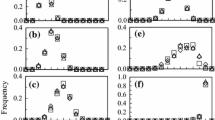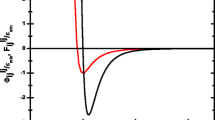Abstract
The definition of random packings of hard spheres, which does not assume any specific features of a short-range order, is considered. The results obtained allow (in particular) us to determine the maximum possible density of a random packing, which has no any types of explicit or hidden long-range order. New computer experiment data, which describe the statistical–geometrical properties of random packings of two-dimensional (2D) and three-dimensional (3D) hard spherical particles, are presented. The behavior of a small group of randomly chosen and fixed spheres at various packing densities and the differences between the properties of this group and the main “large” ensemble (which follow, in particular, from the theoretical results obtained) are investigated. The dependences found experimentally are consistent with the proposed theoretical solution. Let an ensemble consist of N particles occupying total volume V (at packing density η = Nu/V, where u is the particle volume). The maximum possible density of a random packing of spherical particles (ηmax) is specified by the following geometric condition: the average volume of a Voronoi polyhedron in a random close packing cannot be smaller than the average excluded volume for all points of this packing. For an arbitrary point of the ensemble lying at a distance x from the nearest center of sphere (unit radius R = 1), excluded volume w is determined by the following relations. In 2D space, we have w(x) = π(2 – x)2 at 0 ≤ x ≤ 2 and w(x) = 0 at x > 2. In 3D space, we have w(x) = (4π/3)(2 – x)3 at 0 ≤ x ≤ 2 and w(x) = 0 at x > 2. Averaging w(x) for all points of the volume of an ensemble of particles, we can find average excluded volume 〈w〉 for a given packing density η. We can also formulate the following statement, which follows from the condition given above: if packing density η exceeds ηmax, this packing cannot be statistically homogeneous. The approach used in this work can be used to calculate the maximum possible density (upper limit) of a random close packing. This density is ηmax = 0.6813 ± 0.001 (in 2D case of an ensemble of hard disks) and ηmax = 0.6329 ± 0.0005 (for a 3D ensemble of hard spheres).




Similar content being viewed by others
REFERENCES
V. A. Polukhin and N. A. Vatolin, Simulation of Amorphous Metals (Nauka, Moscow, 1985).
N. E. Dubinin, A. A. Yuryev, and N. A. Vatolin, “Pseudopotential calculation of the structure and thermodynamics of liquid alkali metals with a square-well model as a reference system,” J. Struct. Chem. 53 (3), 468–475 (2012).
S. Torquato, “Perspective: basic understanding of condensed phases of matter via packing models,” J. Chem. Phys. 149, 020901–1–31 (2018).
B. A. Klumov, Jin Yuliang, and A. H. Makse, “Structural properties of dense hard sphere packings,” J. Phys. Chem. B 118 (36), 10761–10766 (2014).
V. A. Buryachenko, N. J. Pagano, R. Y. Kim, and J. E. Spowart, “Quantitative description and numerical simulation of random microstructures of composites and their effective elastic moduli,” Int. J. Solids Struct. 40, 47–72 (2003).
V. A. Blatov and V. N. Serezhkin, “Order and topology in systems with many particles,” Acta Crystallogr. A 53, 144–160 (1997).
A. V. Anikeenko and N. N. Medvedev, “Polytetrahedral nature of the dense disordered packings of hard spheres,” Phys. Rev. Lett. 98, 235504-1–235504-8 (2007).
A. A. Berlin, O. V. Gendelman, M. A. Mazo, L. I. Manevitch, and N. N. Sinelnikov, “On solid–liquid transition in plane disc systems,” J. Phys.: Condens. Matter. 11, 4583–4596 (1999).
A. B. Shubin, “The geometric condition for density limits in idealized models of liquids,” Russ. J. Phys. Chem. A 70 (4), 711–712 (1996).
J. L. Finney, “Bernal’s road to random packing and the structure of liquids,” Philos. Mag. 93 (31–33), 3940–3969 (2013).
G. D. Scott, “Packing of spheres: packing of equal spheres,” Nature 188, 908–909 (1960).
J. L. Finney, “Random packings and the structure of simple liquids. I. The geometry of random close packing,” Proc. Roy. Soc. London A 319 (1539), 479–493 (1970).
L. V. Woodcock, “Thermodynamic description of liquid-state limits,” J. Phys. Chem. B 116, 3735–3744 (2012).
J. L. Finney and L. V. Woodcock, “Renaissance of Bernal’s random close packing and hypercritical line in the theory of liquids,” J. Phys.: Condens. Matter 26, 463102–463121 (2014).
J. G. Berryman, “Random close packing of hard spheres and disks,” Phys. Rev. A 27 (2), 1053–1061 (1983).
S. Torquato, T. M. Truskett, and P. G. Debenedetti, “Is random close packing of spheres well defined?,” Phys. Rev. Lett. 84 (10), 2064–2067 (2000).
A. B. Shubin, “On the maximum density of random packing of identical solid spheres,” Rasplavy, No. 1, 93–97 (1995).
A. B. Shubin, “Concerning the geometric limit of the density of a loose medium modeled by identical spherical particles,” J. Eng. Phys. Thermophys. 68 (4), 460–463 (1995).
A. B. Shubin and S. P. Yatsenko, “Geometric constraints for the density limit in the two-dimensional model of liquid,” Russ. J. Phys. Chem. A 73 (1), 140–141 (1999).
A. B. Shubin, “Limiting density of random packing of identical figures in D-dimensional space,” Rasplavy, No. 3, 95–100 (1999).
A. B. Shubin, “Density limit for random close packing of equal figures in D-dimensional Euclidean space,” in Proceedings of the 8th International Conference on Material Technologies and Modeling MMT-2014 (Ariel, 2014), pp. 1-130–1-135.
R. J. Speedy, “Random jammed packings of hard discs and spheres,” J. Phys.: Condens. Matter 10, 4185–4194 (1998).
W. G. Hoover and F. H. Ree, “Melting transition and communal entropy for hard spheres,” J. Chem. Phys. 49 (8), 3609–3617 (1968).
M. Bayer, J. Brader, F. Ebert, et al., “Dynamic glass transition in two dimensions,” Phys. Rev. E 76, 011508–1–12 (2007).
T. M. Truscett, S. Torquato, S. Sastry, P. G. Debenedetti, and F. H. Stillinger, “Structural precursor to freezing in the hard-disk and hard-sphere systems,” Phys. Rev. E 58 (3), 3083–3088 (1998).
S. Meyer, Song Chaoming, Jin Yuliang, Wang Kun, A. Hernán, and A. H. Makse, “Jamming in two-dimensional packings,” Physica A 389, 5137–5144 (2010).
S. Atkinson, F. H. Stillinger, and S. Torquato, “Existence of isostatic, maximally random jammed monodisperse hard-disk packings,” PNAS 111 (52), 18436 (2014).
A. Huerta, D. Henderson, and A. Trokchymchuk, “Freezing of two-dimensional hard disks,” Phys. Rev. E 74, P. 061106-1–061106-4 (2006).
S. Torquato, “Hyperuniform states of matter,” Phys. Rep. 745, 1–95 (2018).
Z. Ma and S. Torquato, “Hyperuniformity of generalized random organization models,” Phys. Rev. E 99, 022115 (2019).
Funding
The work was carried out according to a state assignment to the Institute of Metallurgy, Ural Branch, Russian Academy of Sciences.
Author information
Authors and Affiliations
Corresponding author
Additional information
Translated by K. Shakhlevich
Rights and permissions
About this article
Cite this article
Shubin, A.B. Structural Characteristics of a Small Group of Fixed Particles and the Maximum Density of a Random Packing of Hard Spheres. Russ. Metall. 2021, 181–186 (2021). https://doi.org/10.1134/S0036029521020245
Received:
Revised:
Accepted:
Published:
Issue Date:
DOI: https://doi.org/10.1134/S0036029521020245




